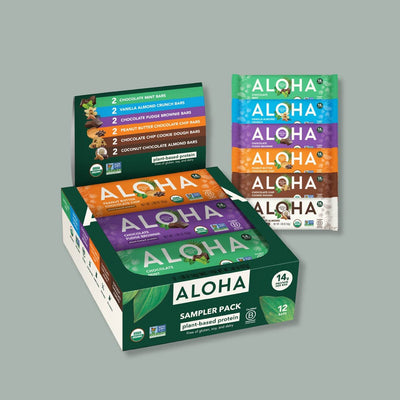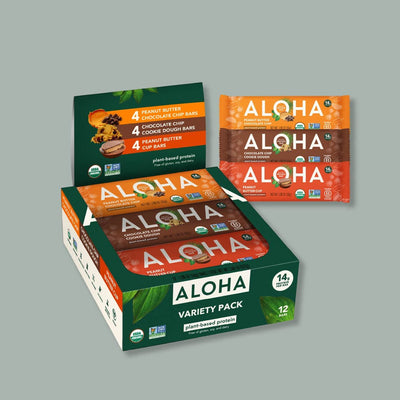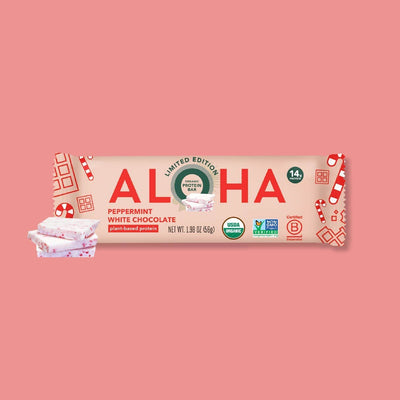Key Takeaways:
- Taro Fits Easily Into Gluten-Free Meals: Its mild flavor and starchy texture make taro a great addition to savory and sweet gluten-free dishes. It blends well with other naturally gluten-free ingredients.
- Whole Taro Is the Safest Option: When prepared fresh at home, taro avoids the risk of gluten contamination. Using clean tools and avoiding shared prep spaces is key.
- Always Read Product Labels: Even though taro is gluten-free, snacks or packaged items made with it might not be. Look for gluten-free certification to stay on the safe side.
Can a humble root vegetable become a staple in your gluten-free lifestyle? Taro has been enjoyed for centuries in many cultures, yet one key question still pops up for those mindful of what goes into their bodies: Is taro gluten-free? With gluten sneaking into unexpected places, knowing exactly what’s on your plate is important.
At ALOHA, we’re more than a plant-based food company — a community-driven brand rooted in transparency, sustainability, and real ingredients. Our special edition Taro Bar highlights one of Hawai'i’s most cherished crops, offering a unique blend of cultural tradition and mindful snacking.
In this piece, we’ll answer the question “Is taro gluten free?”, explore how taro fits into a gluten-free lifestyle, and share helpful tips to enjoy it confidently.
What Is Taro?
Taro is a starchy root vegetable, a dietary staple across many cultures for thousands of years, especially in Pacific Island and Southeast Asian cuisines. With its rough brown exterior and soft, light-purple or white flesh, taro might not look glamorous. Still, its mild, slightly nutty flavor makes it incredibly versatile in sweet and savory dishes.
It’s often cooked, mashed, roasted, steamed, or baked into chips or desserts. In Hawaiian tradition, taro (or kalo) holds deep cultural significance, not only as a food but as a symbol of life and connection to the land.
Taro isn’t just filling—it’s a whole food that fits easily into plant-based lifestyles. Its texture and taste make it a great alternative to other root veggies like potatoes or yams.
Is Taro Naturally Gluten-Free?
Yes, taro is naturally gluten-free. As a root vegetable, it does not contain wheat, barley, rye, or any of the grains that produce gluten. This makes taro a safe and simple choice for individuals who follow a gluten-free diet, whether by necessity or lifestyle.
When taro is prepared in its whole form — such as boiled, steamed, or baked — it remains completely free from gluten. As with any ingredient, the gluten-free status can change depending on how it’s processed or what it’s prepared with. Pre-packaged or flavored taro products could include added ingredients that may not be gluten-free.
So, while the answer to “Is taro gluten-free?” is a confident yes, it still pays to read labels and be mindful when trying taro outside of its whole, unprocessed form.
Why Taro Is A Great Choice For Gluten-Free Diets
Taro fits naturally into a gluten-free lifestyle, not just because it’s free from gluten-containing grains. Its appeal lies in its simplicity and versatility. As a whole root vegetable, taro doesn’t need to be modified, fortified, or reformulated to be gluten-free — it just is. This makes it a trustworthy option for anyone who avoids gluten without complicating their food choices.
Taro's texture is another reason it’s a popular substitute for gluten-based foods. When cooked, it becomes soft and creamy, making it a great stand-in for items like mashed potato porridge or even as a base in gluten-free baking. It’s commonly used in sweet and savory recipes across many cultures, offering a wide range of preparation styles without relying on gluten-containing ingredients.
What makes taro even more appealing for gluten-free diets is its accessibility in various forms. From fresh root at your local market to snack products made with taro like ALOHA’s Taro Bar, it’s easy to find ways to include it in your routine. The keyword here is variety — taro doesn’t just replace one thing; it adds depth and new options to meals that might otherwise feel limited.
How To Enjoy Taro Safely On A Gluten-Free Diet
Taro can be a flavorful, satisfying addition to your gluten-free lifestyle — but like many whole foods, how it’s prepared and served makes all the difference. To keep things safe and stress-free, here’s what to keep in mind when handling or consuming taro-based dishes and products:
- Prepare It Yourself Using Whole Taro Root: Buying taro in its whole form gives you complete control over how it’s cooked and served. When you peel and prepare it at home — by boiling, roasting, or steaming — you keep it free from additives or potential cross-contact. It’s a great way to enjoy taro in its purest, naturally gluten-free state.
- Avoid Cross-Contamination in the Kitchen: Even though taro is gluten-free, using shared kitchen tools can be risky if they’ve touched gluten-containing ingredients. Always use clean utensils, cutting boards, and cookware to prevent accidental exposure. A little caution here goes a long way in maintaining a gluten-free kitchen environment.
- Check Packaged Products for Gluten-Free Certification: Not all taro-based snacks or bars are automatically gluten-free — especially if they’re made in facilities that process wheat. Always read the ingredient list and look for gluten-free certification to be sure. Brands that value transparency make it easier to trust what you’re eating.
- Ask Questions When Dining Out: Taro is sometimes used in restaurant dishes, but it may be combined with sauces, batters, or seasonings that contain gluten. It’s perfectly okay — and encouraged — to ask how it’s prepared. Getting clarity from the kitchen helps you make confident choices when eating out.
Delicious Gluten-Free Products Made With Taro
Taro isn’t just for traditional dishes — it's making its way into modern gluten-free snacks and treats that are both convenient and flavorful. From bars to chips and desserts, taro brings something unique to the table. Here are a few ways you can enjoy taro without worrying about gluten:
- Taro-Based Snack Bars: Some brands are using taro as a star ingredient in snack bars that are gluten-free, plant-based, and made with clean ingredients. ALOHA’s Taro Bar, for example, combines the subtle sweetness of taro with buttery macadamia nuts for a soft, satisfying bite. It’s a great option for a snack that feels a little different but still fits your food preferences.
- Taro Chips and Crisps: Taro chips are a popular alternative to traditional potato chips and are often labeled gluten-free. Just ensure they’re not flavored with seasonings or coatings containing gluten-based additives. Plain or lightly salted versions are the safest pick for those avoiding gluten.
- Frozen and Ready-Made Taro Treats: Some stores carry frozen taro desserts or pre-cooked taro chunks, which can be a convenient way to add taro to smoothies or bowls. These are usually safe if they come with minimal ingredients, but again, always check the label. Simpler products with fewer additives are generally the best choice.
Nutritional Benefits Of Taro Beyond Being Gluten-Free
Taro offers more than just peace of mind for gluten-free eaters — it brings a naturally nourishing profile to the table, with a taste and texture that makes it easy to love. It’s worth highlighting how taro’s essential qualities can add value to a balanced, plant-based lifestyle. Here’s what makes taro a welcome ingredient beyond the absence of gluten:
A Wholesome, Whole Food Ingredient
Taro is a whole, unprocessed root that fits seamlessly into clean eating habits. It’s typically used in its natural state without the need for artificial preservatives or flavorings. That simplicity is ideal for those who appreciate straightforward and close-to-original food.
Versatile In A Plant-Based Kitchen
Taro’s creamy, mild flavor makes it easy to incorporate into savory and sweet dishes. It works well as a base in recipes or as a complement to other ingredients, giving it a flexible role in meals. Whether mashed, baked, or blended, it fits effortlessly into many plant-based cooking styles.
Naturally Satisfying And Filling
When cooked, taro has a hearty, starchy quality that makes meals feel complete. It adds bulk and texture to plates, making it a dependable choice when looking for variety in gluten-free eating. It doesn’t try to mimic other foods — it simply holds its own.
Pairs Well With Other Gluten-Free Ingredients
Taro complements a variety of naturally gluten-free foods like coconut, rice, and legumes, making it easy to build well-rounded meals. Its neutral taste lets other ingredients shine while adding a comforting texture to any dish. This makes taro a dependable base for recipes without gluten-based fillers or flours.
Final Thoughts
Choosing gluten-free doesn’t mean sacrificing variety or connection to tradition — and taro is proof of that. As a naturally gluten-free whole food, taro offers a grounded, nourishing option supporting wellness and cultural appreciation. Whether exploring new ingredients or deepening your plant-based lifestyle, taro invites you to enjoy food that feels honest, satisfying, and rooted in something more meaningful.
Read also:
- Should You Eat Protein Before Or After A Workout?
- How Much Protein Can You Absorb In One Meal?
- When To Drink Protein Shakes For Weight Loss: Best Times
Frequently Asked Questions About Taro Being Gluten-Free
Is taro considered a grain or a vegetable for gluten-free diets?
Taro is classified as a root vegetable, not a grain, so it naturally does not contain gluten. This makes it a suitable choice for anyone avoiding grains that contain gluten, like wheat or barley. It’s more closely related to foods like potatoes and cassava.
Can taro be used to make gluten-free pasta or noodles?
Yes, taro can be blended with gluten-free flour for noodles or pasta alternatives. These products are often found in Asian markets or made at home with custom flour mixes. Just be sure the full ingredient list is gluten-free.
Does taro starch contain gluten?
Like the root itself, Taro starch is gluten-free when processed in a gluten-free environment. However, some products labeled “taro starch” may be mixed with other starches, so reading the label is key. Always confirm that the starch is 100% taro if you’re avoiding gluten.
Is taro safe for people on a wheat-free diet?
Yes, taro is wheat-free and does not contain any wheat proteins. It can be safely included in a wheat-free or gluten-free diet. As always, check for added ingredients when buying packaged taro products.
Does taro need to be certified gluten-free to be safe?
While whole taro doesn't require certification, processed or packaged taro products may need a gluten-free label to ensure safety. Certification helps guarantee the product hasn’t come into contact with gluten during production. For highly sensitive individuals, certified products offer extra peace of mind.
Can I use taro flour as a substitute for wheat flour?
Taro flour can be used as a partial substitute in combination with other gluten-free flour. It doesn’t mimic the structure of wheat flour on its own but adds body and a slightly chewy texture. It works well in pancakes, baked goods, and batter-based recipes.
Is taro root suitable for children on a gluten-free diet?
Yes, taro is a naturally gluten-free and kid-friendly food when cooked until soft. It can be mashed or incorporated into child-safe recipes without gluten. Always make sure it's served plain or with other gluten-free ingredients.
Can taro be served in gluten-free school lunches?
Absolutely. Taro can be included in baked fries, mashed sides, or taro-based snacks in lunchboxes. Just ensure any dips or additions are also gluten-free and school-safe.
Do traditional Hawaiian taro dishes contain gluten?
Traditional taro-based dishes like poi are typically gluten-free, as they use pure taro and water. However, modern variations or fusion recipes may include sauces or flour that contain gluten. If unsure, ask about the ingredients or make it at home.
Can Taro help diversify a gluten-free pantry?
Yes, taro is a great way to bring variety and texture to gluten-free meals. It’s a unique alternative to common starches like rice or potatoes. Keeping taro in your pantry or freezer adds flexibility to your cooking routine.
Sources:
1. Ferdaus, M. J., Chukwu-Munsen, E., Foguel, A., & da Silva, R. C. (2023). Taro Roots: An Underexploited Root Crop. Nutrients, 15(15), 3337. https://doi.org/10.3390/nu15153337
2. Himeda, M., Njintang, Y. N., Gaiani, C., Nguimbou, R. M., Scher, J., Facho, B., & Mbofung, C. M. F. (2012). Physicochemical and thermal properties of taro (Colocasia esculenta sp) powders as affected by state of maturity and drying method. Journal of Food Science and Technology, 51(9), 1857–1865. https://doi.org/10.1007/s13197-012-0697-9
3. Beato, Z., Gitonga, L. N., Amonsou, E. O., & Reddy, V. (2023). Nutritional evaluation of Colocasia esculenta (L.) Schott leaves and corms from KwaZulu-Natal, South Africa. Journal of Food Composition and Analysis, 126, 105831. https://doi.org/10.1016/j.jfca.2023.105831
ALOHA's products are not intended to treat, diagnose, mitigate, prevent, or cure disease. ALOHA's products should not replace prescribed medications or the variety of foods important to a healthful diet.
Do not self-diagnose any health condition. Work with your healthcare provider to determine how best to achieve optimal health.












